| My PIXIE interest started about two years ago when I was looking for a simple transceiver to be built by my builders group that would give a successful contact among the members and provide an effective tool for exploring the art of building a working radio. My first PIXIE was built for show and tell to the group. I built it "Manhattan Style" using parts scrounged from old VCR's , Telephones, Computer modems, etc. From that time on I was hooked on the little radio. My 1st is pictured at the right. It used a switch to offset the frequency between transmitt and receive. |
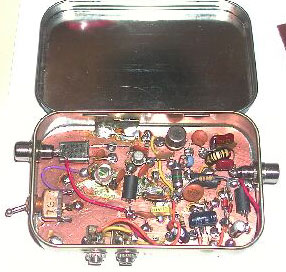 |
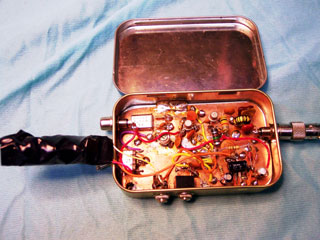 |
After operating it for a short while, I noticed the little things that escape you when your first doing a project like this. My CW skills are not the best and the radio didn't have a sidetone Oscillator so I could hear what I was sending. After looking at a number of designs I settled on the one in W1FB's book using two NPN transistors. I changed another resistor in the PIXIE so that the audio amp didn't mute completely and I was in business. I made some local contacts with my builders group members but any DX seemed to elude me. My side tone was built on a separate piece of PC board and wrapped in Black tape to keep it from shorting out the other stuff and "stuffed" into the Altoids can. It is pictured at left. |
| After some more study and revising my layout to accomidate changes and having much difficulty modifying my first PIXIE. I decided to build unit #2. It has the side tone oscillator laid out on the main board and another automatic switching circuit to provide the frequency offset for the transmitter every time the key was depressed. It really worked better and I tried numerous times to work some DX and was finally successful working a station 875 miles away. But the QRM was terrible. But even with that, the little radio performed well with only 440 Milliwatts of RF output on 40 meters to a simple Dipole antenna. |
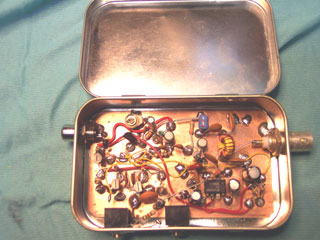 |
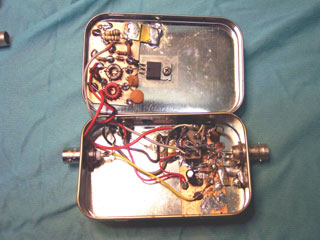 |
Still thinking I could improve the number of contacts per CQ, I surmised that the little radio wasn't putting out enough power to be heard. So I set about to build myself a QRP Gallon Linear. I settled on the design from NORCAL that was used to boost the output of the SMT transciever. It was a simple linear using a Radio Shack Fet transistor. I added a switching circuit from W1FB's Design Notebook to switch the linear inline for transmit and out of line for receive. Now my little radio had a 3.5 watt voice and I was heard more often. The linear is pictured left. |
| Since my CW skills are slow (15 wpm Max) and pushing down a hand key for a long period of time makes my arm ache. I built myself a computer interface that would key the PIXIE and my ROCKMITE by just typing on the keyboard using the HAMCOM program. That really eased the stress on my old bones and made operating much easier. The PIXIE receiver does not have enough signal strength to lock up the CW decoder in the HAMCOM program but it does sometimes lock up with the ROCKMITE receiver and is great for reading the mail. From the success of the decoder I don't think I am the only one using this method. |
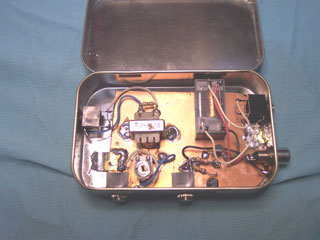 |
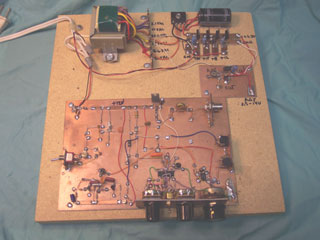 |
So what is next? Well, The QRM problem is the next big hurtle to solve. There are a couple of interesting filter circuits that I am trying to get to work that should fit between the detector and the LM386 audio amplifier. To ease the strain of development of modifications for the PIXIE, I have devised a LARGE SIZE PIXIE that I built on a piece of particle board that I use for building my modifications on. It is pictured at left and has one of the audio filter circuits already built on it ready for some serious testing. Another modification I would like to make on Linear is to switch in a receiver RF amplifier/preselector when the linear is in the receive position. I think that would help the PIXIE's receiver sensitivity. |
|
I will keep working on this little wonder as a matter of choice. It is the ultimate in "bare bones" radios. By all accounts, it is about as minimal as you can go and still have something that works. It is a great Club builders project. Most of the parts can be scrounged from defunct consumer electronics such as VCR's, Telephones, Computer Modems, Boom Boxes, and the like. It is simple to build Manhattan Style which eliminates the need for a Printed Circuit board. About the only parts that you really have to buy are the crystal, the LM386 Audio Amplifier and the core to wind the output filter inductor on. It is about as close to a "FREE" radio as you can get. Here is a picture of my complete PIXIE station that I take with me when I travel. The power supply in the black block is 8 AA penlite batteries in two 4 battery holders hooked in series to give me 12 volts. The headphnes are a pair of Walkman type made by Koss that I got at Walmart for $5.99 and has a small volume control mounted in the cord. The Key is an old Radio Shack Hand Key that I have had for years. If you don't have a hand key there is a number of ways to make one. (one design uses a large paper clip and works great). The PIXIE is set to operate at 7040Khz and my normal antenna is the simple dipole strung up as best I can where ever I am visiting. A modified PAC-12 antenna for 40 meters has also been tried but the dipole just seemed to work better, even at low altitudes. 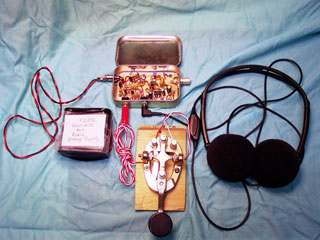 Here are the links to the information that I studied on
the PIXIE Transceiver concepts that I used to make my PIXIE's. http://www.qsl.net/we6w/text/pixie.html This link has a wealth of information on the PIXIE and the PIXIE II and should give you more information for building your PIXIE. http://www.qsl.net/wa4chq/radio.html#Pixie2.
The model of this PIXIE is called the http://www.qrpp-i.com/
This site is the mother load of articles on the PIXIE
transceiver. If you need additional information on My PIXIE Experiments, feel free to email me, I would be glad to hear from you. You can email me at: dhassall@zianet.com |
Back to Dave's Ham Radio Projects page